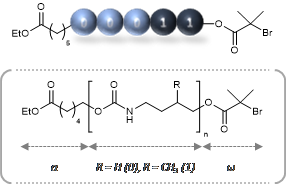The development of strategies that allow the translation of the precise monomer sequence control achieved in nature over macromolecular structure (e.g. DNA) to whole synthetic systems is an exciting field in current polymer science. In particular, the fabrication of sequence-defined polymers paves the way for a diverse range of applications. For example, these macromolecules can be used to store monomer-coded information. Lutz and his team has pioneered this field and recently described the synthesis of digitally-encoded polyurethanes using an orthogonal solid-phase iterative approach. This class of materials is particularly interesting thanks to their unique physicochemical properties and straightforward sequencing by tandem mass spectrometry.
In the current contribution, Lutz and co-workers expand the application pool of these materials by covalently linking sequence-coded oligomers to other synthetic polymers. Sequence-coded oligourethanes were initially synthesized by orthogonal solid phase iterative chemistry on a modified Wang resin. While still attached to the solid support, the ω-OH-termini of the oligourethanes were transformed into atom transfer radical polymerization (ATRP) initiators by esterification with α-bromoisobutyryl bromide. Then, the oligomers were detached from the solid support and their cleaved α -COOH-termini were esterified with ethanol yielding monodisperse ATRP macro initiators. Upon polymerization of styrene from these precise oligomers, well-defined blocky architectures were obtained containing sequence-coded oligourethane segments. The polymerization was well-controlled, yielding materials with narrow molecular mass distributions and good agreement between theoretical and experimental molecular weights. Importantly, for a given macroinitiator length, the coded sequence of oligourethane had no influence on the ATRP process. Overall, these exciting results open up interesting perspectives for the development of plastic materials containing sequence-coded traceability barcodes.
Tips/comments directly from the authors:
- Sequence-coded oligourethanes have an interesting tendency to crystallize, which is currently under investigation. Consequently, these oligomers are usually relatively easy to characterize in solution directly after their synthesis but may become less soluble in standard solvents with time and storage.
- As mentioned in the communication, the tendency toward self-organization of the oligourethanes might influence their macroinitiator behavior. The preliminary results shown in this communication indicate that a controlled radical polymerization behavior is attainable with these macroinitiators. However, a deeper understanding of the initiation step is probably mandatory.
- The atom transfer radical polymerization of styrene was chosen as a simple polymerization model in the present work. Nevertheless, other controlled radical polymerization techniques might, of course, be considered for preparing such materials.
Sequence-coded ATRP macroinitiators Polym. Chem., 2017, 8, 4988-4991, DOI: 10.1039/C7PY00496F
About the webwriter
Dr. Athina Anastasaki is a Web Writer for Polymer Chemistry. She is currently a Global Marie Curie Fellow working alongside Professor Craig Hawker at the University of California, Santa Barbara (UCSB). Please, visit this link for more information.












